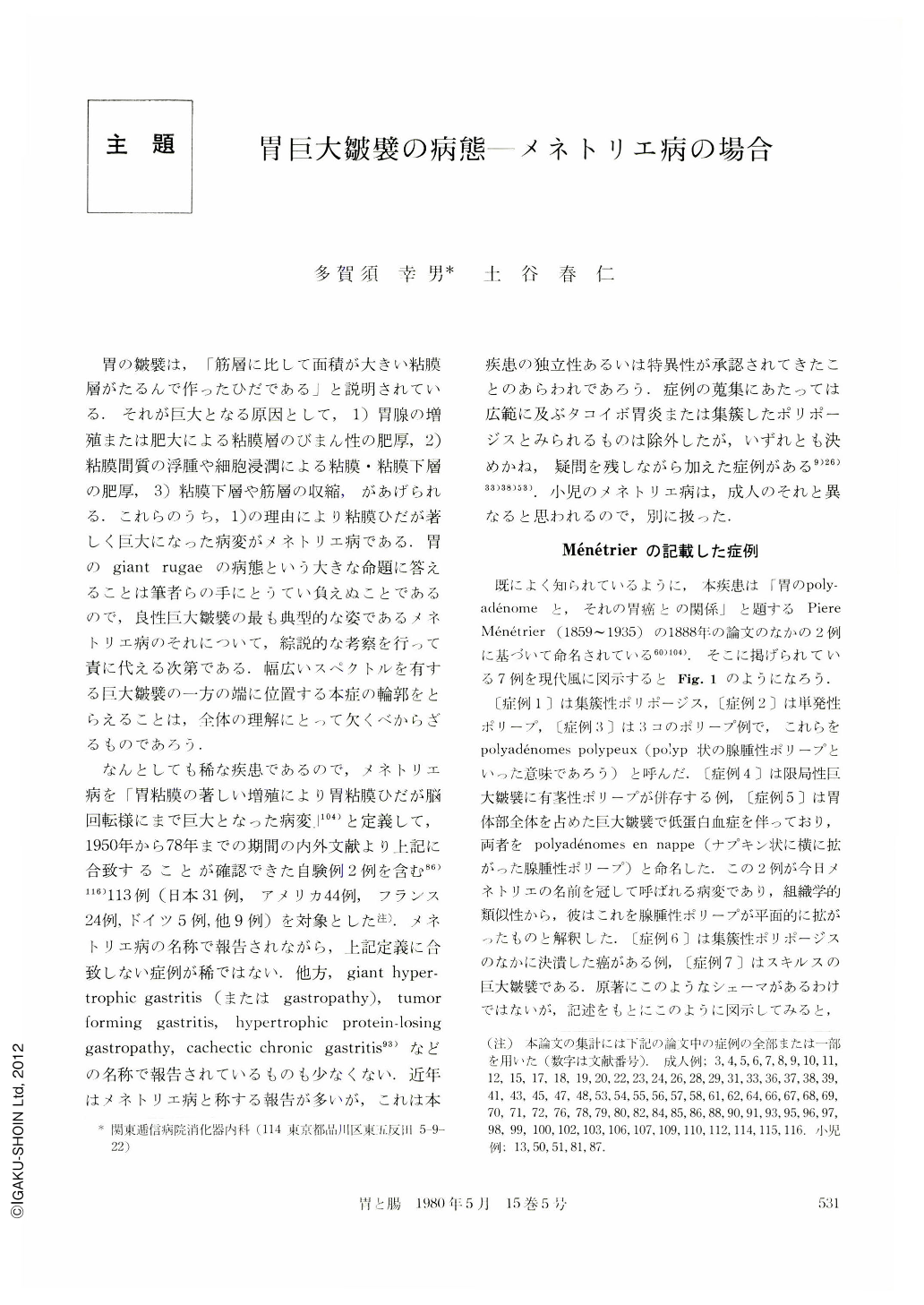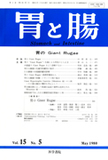Japanese
English
- 有料閲覧
- Abstract 文献概要
- 1ページ目 Look Inside
- サイト内被引用 Cited by
胃の皺襞は,「筋層に比して面積が大きい粘膜層がたるんで作ったひだである」と説明されている,それが巨大となる原因として,1)胃腺の増殖または肥大による粘膜層のびまん性の肥厚,2)粘膜問質の浮腫や細胞浸潤による粘膜・粘膜下層の肥厚,3)粘膜下層や筋層の収縮,があげられる.これらのうち,1)の理由により粘膜ひだが著しく巨大になった病変がメネトリエ病である.胃のgiant rugaeの病態という大きな命題に答えることは筆者らの手にとうてい負えぬことであるので,良性巨大皺襞の最も典型的な姿であるメネトリエ病のそれについて,綜説的な考察を行って責に代える次第である.幅広いスペクトルを有する巨大皺襞の一方の端に位置する本症の輪郭をとらえることは,全体の理解にとって欠くべからざるものであろう.
なんとしても稀な疾患であるので,メネトリエ病を「胃粘膜の著しい増殖により胃粘膜ひだが脳回転様にまで巨大となった病変」104),と定義して,1950年から78年までの期間の内外文献より上記に合致することが確認できた自験例2例を含む86)116)113例(日本31例,アメリカ44例,フランス24例,ドイツ5例,他9例)を対象とした注).メネトリエ病の名称で報告されながら,上記定義に合致しない症例が稀ではない.他方,giant hypertrophic gastritis(またはgastropathy),tumor forming gastritis,hypertrophic protein-losing gastropathy,cachectic chronic gastritis93)などの名称で報告されているものも少なくない,近年はメネトリエ病と称する報告が多いが,これは本疾患の独立性あるいは特異性が承認されてきたことのあらわれであろう.症例の蒐集にあたっては広範に及ぶタコイボ胃炎または集簇したポリポージスとみられるものは除外したが,いずれとも決めかね,疑問を残しながら加えた症例がある9)26)33)38)53).小児のメネトリエ病は,成人のそれと異なると思われるので,別に扱った.
Ménétrier's disease is an extreme model of giant rugae of the stomach. One-hundred-and-thirteen cases including 2 personal ones, which meet the criteria “large, heaped-up folds looking like the convolution of the brain caused by hyperplasia of the gastric glands”, were collected from the world literature published after 1950. Similar disorder of children is omitted because of its transient nature.
It is a very rare disease and only one typical case was diagnosed in our hospital (500 beds) during the past 24 years. It is 6 to 9 times more common in men, most often observed in people between 30 to years old. Chief complaints are ulcer-like epigastric pain, edema, vague epigastric discomfort, gastrointestinal bleeding, weight loss and so on.
Gastric analysis shows hyperacidity in 4.9%, normsin 30.5%, hypo-in 26.8% and anacidity in 37.8%. Volume of basal secretion containing 0.01 to 1.0 g/ (ll of protein is often copious, 400 ml/hr or more. Subsequently 40g or more protein is lost in a day. Fasting gastrin level in the serum is high, 262 pg/ml in the average. Hypoproteinemia under 5.9 g/dl is observed in 45.2% of Japanese cases and 65.5% of western ones. Selected losing of any particular fraction of the serum protein is not demonstrated. Diarrhea enhances hypoproteinemia and anticholinergics partially relieve it by decreasing gastric secretion. Remarkable improvement of it after gastrectomy verifies losing of the serum protein from the stomach.
Extraordinary big size of the stomach is one of the characteristic features. Eighty-nine % of cases are of diffuse type. The gastric body is usually involved and the prepyloric area often remains intact. Gigantic folds are packed together and its surface is like stone pavement. On the microscopic features, there are few things to be added to Ménétriefs detailed description. Heterotopic glands in the submucosa are frequent. A shallow ulcer concealed between the big folds may be the focus of gastrointestinal bleeding.
Gastric cancer is complicated in 6.2% of the cases. In one case cancer developed 6 years after the giant rugae were diagnosed. However, its premalignant nature is not yet confirmed.
Giant folds usually remain unchanged during several year's follow-up. Spontaneous remission to atrophic gastritis was reported in one case. The prognosis after gastrectomy is favorable. After careful investigation of 113 reported cases we are of opinion that it is a special disease belonging to hypertrophic glandular gastritis (H.G.G.). A typical model of H.G.G. is Zollinger-Ellison syndrome. However, its relationship to Ménétrier's disease remains obscure. Certain hormones of the gastrointestinal tract may exert trophic effects on the gastric mucosa. This hypothesis is attractive but there is no discoveries which sustain it.

Copyright © 1980, Igaku-Shoin Ltd. All rights reserved.


